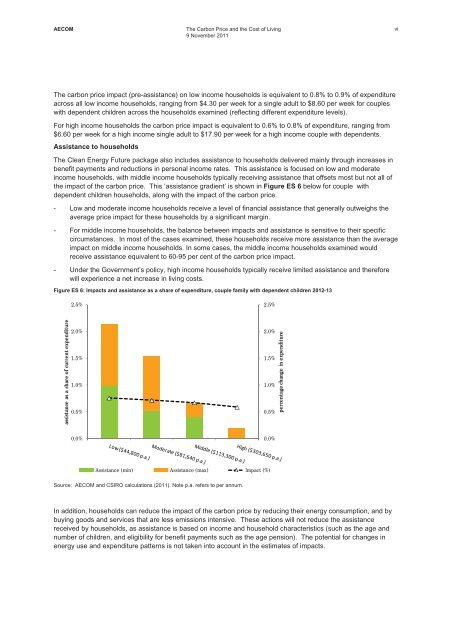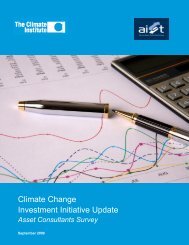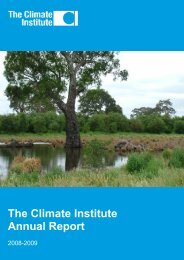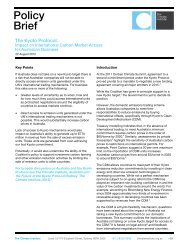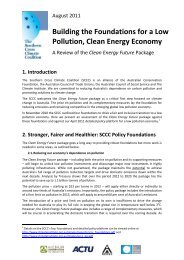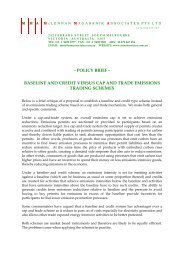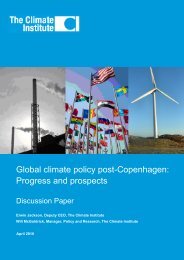The Carbon Price and the Cost of Living - The Climate Institute
The Carbon Price and the Cost of Living - The Climate Institute
The Carbon Price and the Cost of Living - The Climate Institute
You also want an ePaper? Increase the reach of your titles
YUMPU automatically turns print PDFs into web optimized ePapers that Google loves.
AECOM<br />
<strong>The</strong> <strong>Carbon</strong> <strong>Price</strong> <strong>and</strong> <strong>the</strong> <strong>Cost</strong> <strong>of</strong> <strong>Living</strong><br />
9 November 2011<br />
vi<br />
<strong>The</strong> carbon price impact (pre-assistance) on low income households is equivalent to 0.8% to 0.9% <strong>of</strong> expenditure<br />
across all low income households, ranging from $4.30 per week for a single adult to $8.60 per week for couples<br />
with dependent children across <strong>the</strong> households examined (reflecting different expenditure levels).<br />
For high income households <strong>the</strong> carbon price impact is equivalent to 0.6% to 0.8% <strong>of</strong> expenditure, ranging from<br />
$6.60 per week for a high income single adult to $17.90 per week for a high income couple with dependents.<br />
Assistance to households<br />
<strong>The</strong> Clean Energy Future package also includes assistance to households delivered mainly through increases in<br />
benefit payments <strong>and</strong> reductions in personal income rates. This assistance is focused on low <strong>and</strong> moderate<br />
income households, with middle income households typically receiving assistance that <strong>of</strong>fsets most but not all <strong>of</strong><br />
<strong>the</strong> impact <strong>of</strong> <strong>the</strong> carbon price. This ‘assistance gradient’ is shown in Figure ES 6 below for couple with<br />
dependent children households, along with <strong>the</strong> impact <strong>of</strong> <strong>the</strong> carbon price.<br />
- Low <strong>and</strong> moderate income households receive a level <strong>of</strong> financial assistance that generally outweighs <strong>the</strong><br />
average price impact for <strong>the</strong>se households by a significant margin.<br />
- For middle income households, <strong>the</strong> balance between impacts <strong>and</strong> assistance is sensitive to <strong>the</strong>ir specific<br />
circumstances. In most <strong>of</strong> <strong>the</strong> cases examined, <strong>the</strong>se households receive more assistance than <strong>the</strong> average<br />
impact on middle income households. In some cases, <strong>the</strong> middle income households examined would<br />
receive assistance equivalent to 60-95 per cent <strong>of</strong> <strong>the</strong> carbon price impact.<br />
- Under <strong>the</strong> Government’s policy, high income households typically receive limited assistance <strong>and</strong> <strong>the</strong>refore<br />
will experience a net increase in living costs.<br />
Figure ES 6: Impacts <strong>and</strong> assistance as a share <strong>of</strong> expenditure, couple family with dependent children 2012-13<br />
2.5%<br />
2.5%<br />
assistanceasashare<strong>of</strong>currentexpenditure<br />
2.0%<br />
1.5%<br />
1.0%<br />
0.5%<br />
2.0%<br />
1.5%<br />
1.0%<br />
0.5%<br />
percentagechange inexpenditure<br />
0.0%<br />
0.0%<br />
Assistance(min) Assistance(max) Impact(%)<br />
Source: AECOM <strong>and</strong> CSIRO calculations (2011). Note p.a. refers to per annum.<br />
In addition, households can reduce <strong>the</strong> impact <strong>of</strong> <strong>the</strong> carbon price by reducing <strong>the</strong>ir energy consumption, <strong>and</strong> by<br />
buying goods <strong>and</strong> services that are less emissions intensive. <strong>The</strong>se actions will not reduce <strong>the</strong> assistance<br />
received by households, as assistance is based on income <strong>and</strong> household characteristics (such as <strong>the</strong> age <strong>and</strong><br />
number <strong>of</strong> children, <strong>and</strong> eligibility for benefit payments such as <strong>the</strong> age pension). <strong>The</strong> potential for changes in<br />
energy use <strong>and</strong> expenditure patterns is not taken into account in <strong>the</strong> estimates <strong>of</strong> impacts.


